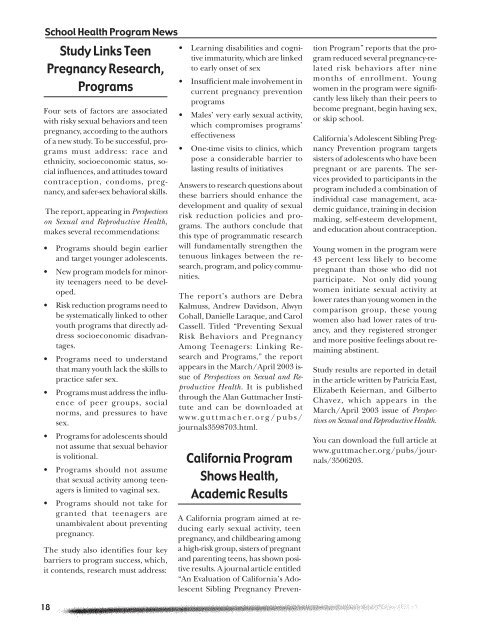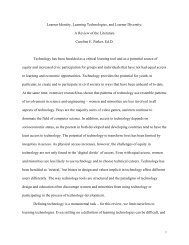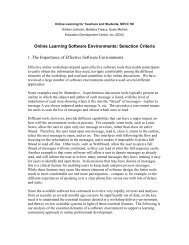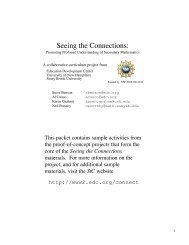School Health Program News - Education Development Center
School Health Program News - Education Development Center
School Health Program News - Education Development Center
You also want an ePaper? Increase the reach of your titles
YUMPU automatically turns print PDFs into web optimized ePapers that Google loves.
<strong>School</strong> <strong>Health</strong> <strong>Program</strong> <strong>News</strong>Study Links TeenPregnancy Research,<strong>Program</strong>sFour sets of factors are associatedwith risky sexual behaviors and teenpregnancy, according to the authorsof a new study. To be successful, programsmust address: race andethnicity, socioeconomic status, socialinfluences, and attitudes towardcontraception, condoms, pregnancy,and safer-sex behavioral skills.The report, appearing in Perspectiveson Sexual and Reproductive <strong>Health</strong>,makes several recommendations:• <strong>Program</strong>s should begin earlierand target younger adolescents.• New program models for minorityteenagers need to be developed.• Risk reduction programs need tobe systematically linked to otheryouth programs that directly addresssocioeconomic disadvantages.• <strong>Program</strong>s need to understandthat many youth lack the skills topractice safer sex.• <strong>Program</strong>s must address the influenceof peer groups, socialnorms, and pressures to havesex.• <strong>Program</strong>s for adolescents shouldnot assume that sexual behavioris volitional.• <strong>Program</strong>s should not assumethat sexual activity among teenagersis limited to vaginal sex.• <strong>Program</strong>s should not take forgranted that teenagers areunambivalent about preventingpregnancy.The study also identifies four keybarriers to program success, which,it contends, research must address:• Learning disabilities and cognitiveimmaturity, which are linkedto early onset of sex• Insufficient male involvement incurrent pregnancy preventionprograms• Males’ very early sexual activity,which compromises programs’effectiveness• One-time visits to clinics, whichpose a considerable barrier tolasting results of initiativesAnswers to research questions aboutthese barriers should enhance thedevelopment and quality of sexualrisk reduction policies and programs.The authors conclude thatthis type of programmatic researchwill fundamentally strengthen thetenuous linkages between the research,program, and policy communities.The report’s authors are DebraKalmuss, Andrew Davidson, AlwynCohall, Danielle Laraque, and CarolCassell. Titled “Preventing SexualRisk Behaviors and PregnancyAmong Teenagers: Linking Researchand <strong>Program</strong>s,” the reportappears in the March/April 2003 issueof Perspectives on Sexual and Reproductive<strong>Health</strong>. It is publishedthrough the Alan Guttmacher Instituteand can be downloaded atwww.guttmacher.org/pubs/journals3598703.html.California <strong>Program</strong>Shows <strong>Health</strong>,Academic ResultsA California program aimed at reducingearly sexual activity, teenpregnancy, and childbearing amonga high-risk group, sisters of pregnantand parenting teens, has shown positiveresults. A journal article entitled“An Evaluation of California’s AdolescentSibling Pregnancy Prevention<strong>Program</strong>” reports that the programreduced several pregnancy-relatedrisk behaviors after ninemonths of enrollment. Youngwomen in the program were significantlyless likely than their peers tobecome pregnant, begin having sex,or skip school.California’s Adolescent Sibling PregnancyPrevention program targetssisters of adolescents who have beenpregnant or are parents. The servicesprovided to participants in theprogram included a combination ofindividual case management, academicguidance, training in decisionmaking, self-esteem development,and education about contraception.Young women in the program were43 percent less likely to becomepregnant than those who did notparticipate. Not only did youngwomen initiate sexual activity atlower rates than young women in thecomparison group, these youngwomen also had lower rates of truancy,and they registered strongerand more positive feelings about remainingabstinent.Study results are reported in detailin the article written by Patricia East,Elizabeth Keiernan, and GilbertoChavez, which appears in theMarch/April 2003 issue of Perspectiveson Sexual and Reproductive <strong>Health</strong>.You can download the full article atwww.guttmacher.org/pubs/journals/3506203.18
















